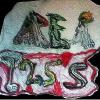I think one can not lack the ability to visualize, otherwise he would not be able to think or even understand speech. Your brain is able to understand what a pig with wings is or what is it not, despite never seeing one in real life. In communities that use techniques requiring visualization, practitioners usually call "lack of the ability to visualize" as unconscious visualization or rapid visualization. In other words you still do it, but you don't notice or are unaware of it. I'm not sure whether this is true when it comes to actual neuroscience, but this resonate with my own experience a bit. Anyway, let's try a simple experiment. Think about your house. Pick 10 distinct places in your house than don't look alike. You can just use my places, if you like:
- Door
- Doormat
- Mirror
- Hanger
- Shoes below the hanger
- Toilet
- Kitchen Table
- Kitchen Sink
- Fridge
- Window in the kitchen
Now the experiment (the example uses the places I have above):
- Fat Man. Think about a fat hairy naked man rubbing his sweaty manboobs on your front door. "Do have a beer?", he asks, as he burps loudly.
- Ants. Think about the doormat. It's covered with giant ants. One ant is so big that it's chewing on a corner of a doormat. You're trying to be careful and not to step on any ants.
- Dog. Think about a dog looking at itself in your mirror and saying to you "What are you looking at bro, I need to look pretty to get all the bitches.". It's an extremely furry dog too. It also sniffs the mirror and lick it a couple of time, leaving drool all over it.
- Toilet paper. Think about toilet paper on a hanger. Who covered the hanger in toiled paper? Is this a prank? It's all over the clothes, it's everywhere. Perhaps you can wear a toilet paper today? Is this a new fashion?
- Blood. Think about shoes below the hanger being covered with blood. You try to put your foot in there and it's soaked in blood, "WHAT THE F..."
- Ship. Think about a huge ship suddenly appearing out of a toilet. Water splashes on the floor near. Its sails are so big that they manage to push and drop the toilet paper onto the floor. You just wanted to take a shit and now you have to take a ship.
- Baby. Think about the kitchen table. There is newborn baby on your table. Its umbilical cord is still attached and hanging in hair between the table and the floor. The baby is screaming loudly. You think you wouldn't eat a baby, so why is it on your table.
- Baboon. Think about the kitchen sink. There is a baboon in there washing its red butt. In fact, there was a dirty plate in your sink. Baboon, picks it up and throws the plate at you, making some primal sounds. Apparently, in some gesture of dominance or pointing out how rude it is to leave your dishes where baboons wash their asses. How rude indeed.
- Head. Fridge. You open it and there is a head in there. Its eyes open, it looks at you and whispers, "Help me. So cold. Find my body." But then it starts to chew on your vegetables.
- Soccer ball. Think about the window. You try to look outside, but a soccer ball breaks the window and hits you in the head. Glass shatters everywhere. It bounces off your head and gets stuck on a piece of broken glass that is still attached to the frame. It's slowly deflating, making "shhh" sounds as the air inside escapes.
Now don't look at the objects that you tried to remember (1: fat man, 2: ants, 3: ..). Only look at the first list, which consists of places / objects in your home. Now, just looking at the first list, try to remember what objects is associated with each place (door: fatman, doormat: ants). With enough practice, you will be able to remember all ten of them, then all hundred and even all thousand, if you want. The only reason you can remember them, is because you were able to visualize this. You can't hold that many objects in your head in the short term memory.
You can test that this is about using visual memory, because it will override things. In fact, try to remember all 10-100 things by imagining them in your kitchen sink. You won't be able to. Each thing will override another. But if you imagine 10-100 things each having its own place, then it will be easy. So it's like painting. You paint one image in one place. If you try to paint several images in the same place, only last one / most vivid one will be visible. Also, to convince yourself that this is visual memory (in case you don't notice how you remember it), you can try to remember 20 car models you know or any other look alike objects, it will be incredibly hard. The more visually distinct the objects are the easier it will be to remember them. If you practice this enough, you will start to understand how you do it, you will start to notice images inside your head.
To further explore why this relies on visualization, try to remember objects like "economy", "love", "eternity", "infinity", "friendship". Remembering, friendship as visual object like a dog will be much easier than remembering friendship as an abstract idea.
I was into many different things when I was younger, including lucid dreaming. I was also curious about various new-agy material like NLP seminars (I'm not saying any of them were / are scientifically credible) and I never understood what they meant by changing a representation's color to black and white or making the imagine small and distant. Over the years, mnemonics gave me the best idea and control over my own visualization. It's inevitable to start to understand visualization, when you stress your brain to rely on visualization. You perform a task, effectiveness of which directly depends on how well you can imagine something.
When people visualize they never really see an image as clearly as the real object (perhaps unless you have a mental disorder). I think this is what you're confused about . You can't see an imaginary image as real one. Imagination is very fast and dynamic. For me it's hard to hold an image, it constantly changes or moves. It's a bit like a lucid dream. In a lucid dream you can't hold a dream in a stead state. If you have a lucid dream, try to just sit there do nothing and stare at the wall. It won't be static. You'll either wake up or something will change (it's not just my experience, most people claim this to be true).
Anyway, I hope that was helpful. You can do it with many different objects and more places. Try to remove completely sounds and ideas when you associate objects with each other. I cheated a bit when I described you an example of how you can associate them. I used many modalities (auditory: baby was screaming, fat man was burping..; ideas: dog near mirror because it wanted to look good to get bitches, baboon being angry at you for putting your dirty dishes near it). Then, if you're already only in visual modality, you can dial down the intensity of it. I described the baby on a table with the umbilical cord intact. It's even more disturbing that I mentioned eating it. It's on purpose. That is a quite intense experience and hard to forget, if you really think about it. But with more experience, you might realize that you only need to distort one object with another to remember it.
In other words, when you see one object it has to contain a part of another object on it. Also association itself happens instantly, you can memorize it in 1-6 seconds. If you do it more than 6 seconds per object, you're probably overdoing it. For example, dog -> mirror. Dog bites the side of the mirror. Earth -> Table. Dirt on the table. The crucial part, in my experience, is that dog is in contact with the mirror and that dirt is in contact with the table. I call it distorting one object with another. E.g. imagine mirror jumping up and down. Then imagine dog biting the right side of the mirror. Then mirror being dirty. All those are distortions of one object, but they can co-exists. As soon as you imagine, e.g., a train smashing the right side of the window, the dog is gone. It's pretty much as erased as if you would press delete on your harddrive, or more accurately, painted something on top of something else. Now there is a train instead. That being said, it does not mean that you actually erased the image from your memory. I personally like to think about it as changing a pointer to another memory (speaking in computer science terms) or having another key or painting something on top of something else. A side of a mirror is key that opens a memory (a dog). Sometimes, you can't quite fit that key, but you try again then it fits and the memory appears. It sometimes opens a whole gestalt, i.e., you can remember how a room smelled like when you imagined a dog biting a mirror, in what place and context you memorized it and whether it was dark outside the window.
It's a simple memory palace technique. If you can remember 5 things this way, you can do hundreds of associations with near perfect accuracy. The size does not matter, that's why memory champions can remember thousands of random cards.
You can also try chaining objects with each other like fat man -being bitten by-> ants --getting their butts sniffed by-> a dog --being stuck in--> toilet paper -that has -> blood on it -->which has a ship swimming (in the the blood) -> a ship -- has -> a baby captain on it --on baby's shoulder -- there is --> a baboon who speaks like a parrot --- baboon has a -> head stuck inside its ass -- a head bounces --> soccer ball on its nose --> ∞. Again, to test that this is visual, you can try adding repeated elements to your random chain of objects that you want to associate with each other. Put two baboons in there or four dogs. (ship -> dog -> baboon -> blood -> dog -> watermelon -> baby -> dog). Things will start to overwrite each other, as surely as if you would try to paint two things over one another. The more you do those exercises, the more visualization intuition you're going to develop. In fact, there might be "aha" moments when you failed to remember something, like "Aha, I failed to memorize this because the dog was not really biting the mirror, it was standing near the mirror, so when I looked just at the mirror trying to remember an associated object, the mirror itself was empty and I failed to see the dog."
Going a bit off topic, years ago I attempted some interesting experiments with visualization inside a lucid dream. The plan was to use mnemonics inside a lucid dream. I wanted to memorize there a sequence of objects (using a memory palace) and then remember them on waking up. Needless to say, it's quite complicated logistically. I tried it once and I did not succeed, because I was not lucid enough. In other words, something distracted me and I went on doing my usual dream business. Then life happened and I did not have enough time to practice lucid dreaming. But there was still a period where I remember imagining something while standing a room. The room in a dream started to fade out the more I imagined the object. So I used the usual technique of touching everything I can in a dream to make it stable. In that dream I was standing in a kitchen. I was touching and rubbing walls to prevent the dream from fading away , while I was visualizing objects that I tried to remember. Unfortunately, it was long ago and I got distracted pretty quickly, so I don't remember all the details.
Now now as I'm older and I have a more scientific mindset, I wonder whether it's actually possible to imagine something inside a dream or whether that will appear as a real object in that dream (I don't remember how my imagination looked there, e.g. if there was a wall behind my imaginary object, or if the imaginary object started to look real as soon as I wished to imagine it). It is an interesting question, in my opinion, as right now I can imagine a banana and quickly focus back on a wall that is in front of me. Banana clearly looks imaginary and the wall is clearly real. But it will be a bit fascinating to see whether the brain will have same two "channels", when something is imagined inside a dream. For somebody who has experience with lucid dreaming, the experiment would be to try to stand in room in a dream and imagine another room as your memory palace and try to remember random objects. Then watch whether you're able to both be in a room in a dream and imagine objects inside your memory palace. The only problem is that with dreams is that you're never really conscious in them and it's hard to determine whether you BELIEVE that you're doing something in there or whether you're actually doing it. You might be thinking that you're imagining something, but in reality there is a "real" object floating in the middle of the room or something like that. That would be easy to test, as the object should be in your memory palace when you wake up and not in the room that you were standing in a dream. I wish I would experiment more with it and actually be able to pay attention to a real dream object (like a wall in a room I'm standing in) behind the imaginary object and be lucid enough to compare that experience to the waking state.
If anybody practices lucid dreaming, I think that will be an interesting thing to try.





































































